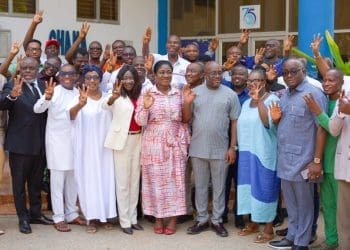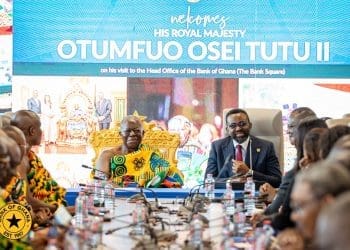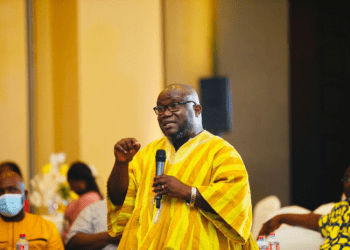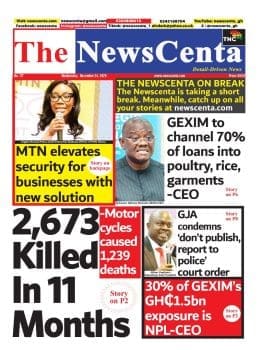Azumah Resources Ghana, majority owner of the Black Volta gold mine in the Upper West Region, has abruptly terminated its proposed sale agreement with Engineers & Planners Co. Limited’s (E&P) owned by Ibrahim Mahama, and announced that it has “officially started construction of the Black Volta gold mine,” calling into question E&P’s recent $100 million Acquisition Facility Agreement with the ECOWAS Bank for Investment and Development (EBID).
In a blistering statement issued days before E&P’s signing ceremony with EBID—scheduled for Monday, July 7, 2025—Azumah declared itself “in a position to proceed with construction at pace without E&P,” having worked “closely with our shareholders, the Government of Ghana, the Ministry of Lands and Natural Resources and the Minerals Commission” to secure all necessary regulatory authorisations and project financing.
EBID deal vs. Azumah’s reversal
E&P’s $100 million facility was explicitly structured to fund not only the acquisition of the Black Volta Project but also the infrastructure, machinery and workforce training required advancing the mine to full operation.
The mine itself is now valued at over $300 million—an increase that Azumah cited as evidence of “Ghana’s aspiration to foster indigenous ownership in large‑scale mining.”
Yet, Azumah’s renunciation of the sale agreement has left investors and government officials scrambling for clarity.
Behind the scenes: Debt and delays
Investigations by NorvanReports reveal that, at the time Azumah purportedly approached E&P, it was grappling with outstanding liabilities to Ghanaian regulators—including more than $3 million owed to the Ghana Revenue Authority (GRA).
According to internal communications obtained by NorvanReports, Azumah’s Australian shareholders initially offered E&P the first right to buy the mine site on terms that would see the Ghanaian firm raise $100 million and repay the debt over two years.
However, the transaction hit turbulence almost immediately. A target signing date of August 2023 was pushed back repeatedly. In a July 23, 2024, email, James Wallbank of Ibaera Capital—acting for the Azumah consortium—extended the EPC agreement and equity financing deadline to July 30, financing to August 30, and the first payment milestone to December 31, 2024.
Yet, the fully executed agreement only reached E&P in late November 2023, hampering E&P’s ability to secure lenders.
E&P’s financial lifeline and legal steps
Despite the delays, E&P stepped in to keep the project alive—injecting roughly $500,000 per month into operations and taking the lead on renegotiating Azumah’s GRA obligations to avert mine foreclosure.
Company documents show E&P even continued paying Azumah staff salaries as late as June 2025, well after Azumah’s claim of terminating the agreement in December 2024.
Frustrated by unilateral board actions—such as attempts to dissolve the project’s finance committee and sideline E&P—Engineers & Planners sought judicial intervention.
In June 2025, the High Court of Ghana granted an interim injunction confirming that the sale agreement remains binding until arbitration concludes.
The court barred Azumah from selling the mine, raising fresh funding, or appointing new leadership without E&P’s consent, acknowledging that E&P’s multi‑million‑dollar investments would suffer “irreparable harm” if Azumah acted alone.
Gold prices and moving goalposts
Sources close to the transaction suggest that a sudden revaluation of the mine was the tipping point.
With Black Volta now pegged at over $300 million, Azumah’s shareholders allegedly demanded a new purchase price—allegedly telling E&P, “If you don’t pay us $300 million, you can forget it”—even as E&P continued funding the venture.
“Do you think EBID, after hiring a French firm to conduct due diligence, would approve the facility if E&P had no legal stake?” one representative told NorvanReports, underscoring the depth of E&P’s financial and operational commitments.
Construction commences—with or without E&P
Undeterred, Azumah says it has mobilised shareholders’ financing to kick‑start on‑site preparatory works, including infrastructure, civil engineering and recruitment.
Project director Rob Ciccini affirmed, “We are extremely pleased that our existing shareholders have reconfirmed their long‑term commitment to Ghana and the construction of the Black Volta Project.”
Azumah anticipates more than 1,000 jobs during the construction phase, followed by hundreds of permanent roles once production begins.
A precedent‑setting dispute
As International Chamber of Commerce arbitration looms, the Black Volta standoff raises profound questions about contract sanctity, financing obligations and governance during commodity‑price surges.
E&P asserts it has invested over $4 million to date; Azumah insists on its right to self‑fund.
With a mine potentially worth hundreds of millions, the eventual ruling will reverberate through Ghana’s—and West Africa’s—mining sector, shaping how future local‑international partnerships are structured.
For now, July 7, 2025’s EBID signing ceremony proceeds under a cloud of uncertainty—and amid competing proclamations of who truly owns Ghana’s newest large‑scale gold operation.
The Black Volta Gold Project represents one of the largest gold exploration positions in Ghana held outside of the major multinational mining companies.
Covering approximately 934 square kilometres under a combination of mining and exploration licences, the project boasts a significant secured land package with substantial upside potential.
Project highlights
Simplicity in Development: One of the key advantages of the Black Volta Mine is the straightforward nature of its development plan, making it an efficient and cost-effective project to bring into production.
Production forecast
The mine is expected to produce an average of 163,000 ounces of gold per annum over the first five years, and 148,000 ounces annually over the first nine years of operation.
Mine life
The project has an initial mine life estimate of 11 years.
Reserves and resources
Current estimates indicate a gold reserve of 1.37 million ounces and a broader mineral resource base of 2.8 million ounces.
Additional targets
The licence area includes multiple high-potential exploration targets that remain underexplored, offering significant scope for resource expansion.
Promising anomalies
A particularly strong gold anomaly has been identified north of Bepkong, extending over more than 8 kilometres—significantly larger than the footprint of the currently known deposits.
Depth extensions
The project’s geology suggests strong potential for deeper mineralisation.
Current drilling at Kunche has been shallow, with most holes terminating above 300 metres.
This presents a major opportunity to extend resources at depth, in line with similar gold deposits elsewhere in West Africa.













